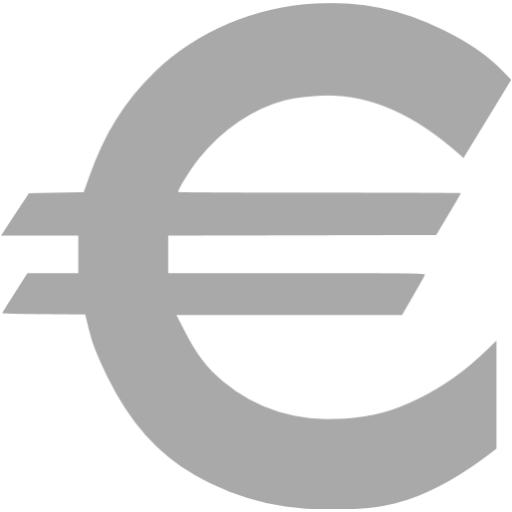Unveiling The Symbol Of The Euro: A Comprehensive Guide
The symbol of the euro has become one of the most recognizable icons in global finance. It represents not just a currency but also the unity and economic strength of the European Union. If you’ve ever wondered about the origins, meaning, and significance of this iconic symbol, you’re in the right place. Let’s dive into everything you need to know about the euro symbol.
From its design to its global impact, the euro symbol plays a crucial role in shaping how we perceive the euro as a currency. Whether you’re a finance enthusiast, a traveler, or simply curious about the world of money, understanding the euro symbol can give you a deeper appreciation for its importance.
In this article, we’ll explore everything from the history of the euro symbol to its practical applications in everyday life. So, buckle up and get ready to discover the fascinating story behind this powerful symbol!
Read also:The 100000 Pyramid Unlocking Secrets And Building Wealth
Table of Contents
- History of the Euro Symbol
- Design and Meaning of the Euro Symbol
- How the Euro Symbol Was Created
- Where and How the Euro Symbol Is Used
- Global Impact of the Euro Symbol
- Economic Significance of the Euro Symbol
- Comparison with Other Currency Symbols
- The Euro Symbol in the Digital Age
- Future of the Euro Symbol
- Conclusion
History of the Euro Symbol
Let’s rewind the clock and take a trip back to the late 1990s when the European Union was gearing up to introduce a unified currency. The euro wasn’t just about creating a new way to pay for stuff; it was about fostering unity among member countries. And what better way to symbolize that unity than with a unique symbol?
The euro symbol was officially unveiled in December 1996, long before the currency itself started circulating in 1999. This decision was made to ensure that the euro had a strong visual identity even before it hit the streets. The symbol was designed to reflect the values of stability, strength, and cooperation among European nations.
But here’s the kicker—choosing the euro symbol wasn’t an easy task. A panel of experts reviewed hundreds of designs before settling on the one we know today. It had to be simple, memorable, and easy to reproduce across different mediums. And let’s be honest, they nailed it!
Why Was the Euro Symbol Needed?
Before the euro symbol came into existence, currencies like the German Mark and French Franc had their own distinct symbols. The euro needed something just as iconic to stand out on the global stage. Plus, having a universal symbol made it easier for businesses, travelers, and everyday folks to recognize and use the currency.
Design and Meaning of the Euro Symbol
Now, let’s talk about the design of the euro symbol itself. At first glance, it might look like a fancy letter E, but there’s so much more to it than meets the eye. The symbol consists of a stylized E with two horizontal lines running through it. Simple, right? Well, there’s some serious symbolism packed into those lines.
The E shape represents Europe, obviously. But the two parallel lines crossing through it signify stability and balance—qualities that are essential for any currency. The curved lines at the top and bottom of the E also give the symbol a sense of movement, which symbolizes progress and dynamism. It’s like the euro is always moving forward, just like the European economy.
Read also:Robert De Niros 7 Children Everything You Need To Know About His Family Life
And guess what? The euro symbol is actually based on the Greek epsilon character, which is a nod to the rich history and heritage of Europe. So, it’s not just a random design—it’s a carefully crafted representation of everything the euro stands for.
What Makes the Euro Symbol Unique?
When you compare the euro symbol to other currency symbols, you’ll notice that it has a certain elegance and simplicity. Unlike the dollar sign ($), which is a bit more angular, or the yen symbol (¥), which is straightforward, the euro symbol has a smooth, flowing design that feels modern yet timeless.
How the Euro Symbol Was Created
Alright, here’s where things get interesting. The creation of the euro symbol wasn’t just a one-person job. A team of talented designers and economists worked together to bring this iconic symbol to life. The process involved brainstorming sessions, sketching countless designs, and getting feedback from all over Europe.
One of the key figures in this process was a designer named Arthur Eisenmenger. He played a major role in shaping the final design of the euro symbol. Eisenmenger wanted to create something that would resonate with people across different cultures and languages. And boy, did he succeed!
But it wasn’t just about aesthetics. The team also had to consider practical aspects, like how the symbol would look on coins, banknotes, and digital screens. They even tested the design with people who had visual impairments to ensure it was accessible to everyone.
Challenges in Designing the Euro Symbol
Designing a symbol that would represent an entire continent wasn’t without its challenges. One of the biggest hurdles was creating something that would appeal to all 27 member states of the European Union. Each country had its own preferences and cultural nuances, so finding a design that worked for everyone was no small feat.
Where and How the Euro Symbol Is Used
Now that we’ve covered the history and design of the euro symbol, let’s talk about how it’s actually used in real life. You’ll find the euro symbol everywhere—from price tags in stores to financial reports and even on your phone when you’re typing messages. It’s become such an integral part of daily life that most people don’t even think twice about it.
But did you know that there are specific guidelines for how the euro symbol should be used? For example, it should always appear before the amount (e.g., €10) and not after like some other currencies. This might seem like a small detail, but it helps maintain consistency across different languages and regions.
And let’s not forget about digital usage. In the age of online shopping and digital payments, the euro symbol plays a crucial role in ensuring that transactions are clear and easy to understand. Whether you’re booking a flight or buying groceries online, the euro symbol is there to guide you.
Proper Usage of the Euro Symbol
While most people use the euro symbol correctly, there are still some common mistakes to watch out for. For instance, some folks accidentally place the symbol after the amount, which can cause confusion. Another mistake is using the wrong font or style, which can make the symbol look inconsistent.
Global Impact of the Euro Symbol
The euro symbol has had a massive impact on the global stage. As the official currency of 19 European countries, the euro is one of the most widely used currencies in the world. And the symbol plays a big part in its success.
For starters, the euro symbol has helped establish the euro as a major player in international trade and finance. It’s become a symbol of economic stability and trust, which is crucial in today’s global economy. Plus, it’s made it easier for businesses and consumers to navigate the complexities of cross-border transactions.
But the impact goes beyond just economics. The euro symbol has also become a cultural icon, representing the ideals of unity and cooperation that the European Union stands for. It’s a reminder that, despite our differences, we can come together to achieve great things.
How the Euro Symbol Influences Perception
When people see the euro symbol, they often associate it with strength and reliability. This perception has helped the euro gain widespread acceptance, even in countries outside the European Union. It’s like the symbol itself carries a sense of trustworthiness that extends beyond the currency itself.
Economic Significance of the Euro Symbol
From an economic perspective, the euro symbol is more than just a visual representation of a currency. It’s a tool that helps drive economic growth and stability. By providing a clear and consistent way to represent the euro, the symbol makes it easier for businesses to operate across borders and for consumers to make informed financial decisions.
But the economic significance of the euro symbol goes deeper than that. It’s also a symbol of the European Union’s commitment to economic integration. By adopting a single currency and symbol, member countries have shown that they’re willing to work together to create a stronger, more resilient economy.
And let’s not forget about the psychological impact. When people see the euro symbol, they feel a sense of security and confidence in the currency. This trust is essential for maintaining economic stability and promoting growth.
Challenges Facing the Euro Symbol
Of course, no symbol is without its challenges. One of the biggest issues facing the euro symbol is the rise of digital currencies and cryptocurrencies. As more people turn to digital payment methods, the role of traditional currency symbols like the euro may evolve. However, the euro symbol remains a powerful force in shaping how we think about money.
Comparison with Other Currency Symbols
Now, let’s take a moment to compare the euro symbol with other major currency symbols. While each symbol has its own unique qualities, the euro stands out for its simplicity and elegance. Unlike the dollar sign, which can sometimes feel a bit harsh, or the pound sterling symbol (£), which has a more ornate design, the euro symbol strikes a perfect balance between form and function.
And when it comes to global recognition, the euro symbol is right up there with the best of them. It’s instantly recognizable, whether you’re in Paris, Berlin, or Rome. This level of recognition is a testament to the symbol’s effectiveness in representing the euro as a world-class currency.
Why the Euro Symbol Stands Out
One of the reasons the euro symbol stands out is its ability to transcend language barriers. Unlike words, which can vary greatly from one language to another, symbols like the euro provide a universal way to communicate. This makes it easier for people from different countries to understand and use the currency.
The Euro Symbol in the Digital Age
As we move further into the digital age, the role of the euro symbol continues to evolve. With more and more transactions happening online, the symbol has become an essential part of digital commerce. It’s used in everything from e-commerce platforms to mobile payment apps, ensuring that people can easily identify and understand prices in euros.
But the digital transformation isn’t without its challenges. As technology advances, there’s a growing need to ensure that the euro symbol remains accessible and user-friendly across all devices and platforms. This requires ongoing innovation and adaptation to keep up with changing trends and technologies.
Future Developments for the Euro Symbol
Looking ahead, there’s no doubt that the euro symbol will continue to play a vital role in the digital economy. As new technologies emerge, such as blockchain and artificial intelligence, the symbol may evolve to meet the demands of the modern world. But one thing is certain—the euro symbol will always remain a powerful symbol of unity and progress.
Future of the Euro Symbol
So, what does the future hold for the euro symbol? While it’s impossible to predict exactly how the symbol will evolve, one thing is clear—it will continue to be an important part of the global financial landscape. As the European Union grows and expands, the euro symbol will play a key role in representing the economic and cultural values of its member countries.
But the future of the euro symbol isn’t just about economics. It’s also about innovation and creativity. As new technologies and trends emerge, the symbol will need to adapt to remain relevant and effective. This means embracing change while staying true to its core values of stability, unity, and progress.
Conclusion
In conclusion, the euro symbol is much more than just a visual representation of a currency. It’s a powerful symbol of unity, strength, and progress that has had a profound impact on the global economy. From its humble beginnings in the late 1990s to its current status as one of the most recognizable symbols in the world, the euro symbol has come a long way.
As we’ve explored in this article, the euro symbol plays a crucial role in shaping how we think about money and the economy. Whether you’re a business owner, a traveler, or just someone who’s curious about the world of finance, understanding the euro symbol can give you a deeper appreciation for its importance.
So, the next time you see the euro symbol, take a moment to appreciate all that it represents. And if you found this article helpful, don’t forget to share it with your friends and family. Together, we can spread the word about the fascinating story behind this iconic symbol!
Article Recommendations


